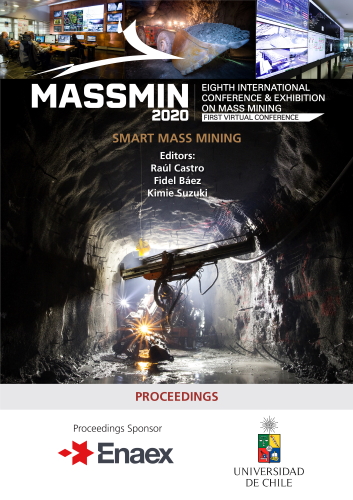The application of civil engineering construction practices in cave mines for improved extraction and reliability

|
Authors: Colbeck, SO; Elliott, J |
This paper is hosted with the kind permission of Lulea University of Technology, International Conference & Exhibition on Mass Mining, 2024.
DOI https://doi.org/10.36487/ACG_repo/2063_54
Cite As:
Colbeck, SO & Elliott, J 2020, 'The application of civil engineering construction practices in cave mines for improved extraction and reliability', in R Castro, F Báez & K Suzuki (eds), MassMin 2020: Proceedings of the Eighth International Conference & Exhibition on Mass Mining, University of Chile, Santiago, pp. 787-799, https://doi.org/10.36487/ACG_repo/2063_54
Abstract:
The combination of a high-quality construction approach typical of that used in civil engineering construction together with the higher tolerance for deformations, water inflows and shorter design life typical of mining construction, allows for the capacity of ground support linings to be significantly increased compared to both typical civil and mining applications. This ability to push the envelope of liner ground support performance through the use of structural support liners, these being distinct from typical sprayed concrete, rock bolt and mesh liners used in most underground developments, allows for enhanced optimization of extraction and draw point reliability through adjustment of the panel layout. This paper highlights current civil engineering construction technologies that can be utilized to improve liner and draw point reliability in caving operations, including NATM type yielding liner systems and high strength composite steel and concrete liner systems, and further describes how standard civil engineering design practice should be re-imagined to support both practicality and relevance in the cave mining context where appropriate structural failure is the hallmark of good design. It is suggested that this is facilitated by the adoption of a Managed Failure Limit State as opposed to the conventional Ultimate Limit State partial safety factor design approach in common use in civil engineering design. Finally, this paper considers the potential conditions that might require each of three typical hybrid civil-mining support systems that are relevant to a recent block cave extraction level tunnel system.
References:
BSI 2002, BS EN 1990:2002 ‘Eurocode – Basis of structural design’, British Standards Institute, London.
BSI 2004, BS EN 1992-1-1:2004 ‘Eurocode 2 – Design of concrete structures - Part 1-1: General rules and rules for buildings’, British Standards Institute, London.
CIRIA 1977, ‘Report 63 Rationalisation of safety and serviceability factors for structural codes’, Construction Industry Research and Information Association, London.
Palmstrom, A 1993, ‘The New Austrian Tunnelling Method (NATM)’ in AM Myrvang (ed.), Fjellsprengningsteknikk, Bergmekanikk, Geoteknikk 1993, Oslo, pp. 31.1-31.20.
Steiner, P 2019, ‘hiDCon – high Deformable Concrete an overview of projects’, Powerpoint Presentation, viewed 15th July 2020,< >
© Copyright 2025, Australian Centre for Geomechanics (ACG), The University of Western Australia. All rights reserved.
View copyright/legal information
Please direct any queries or error reports to repository-acg@uwa.edu.au
View copyright/legal information
Please direct any queries or error reports to repository-acg@uwa.edu.au
